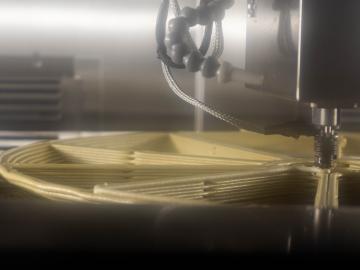
Filter News
Area of Research
- Advanced Manufacturing (9)
- Biology and Environment (28)
- Computer Science (5)
- Electricity and Smart Grid (1)
- Energy Science (84)
- Fuel Cycle Science and Technology (1)
- Functional Materials for Energy (2)
- Fusion and Fission (12)
- Fusion Energy (1)
- Isotope Development and Production (1)
- Isotopes (2)
- Materials (53)
- Materials for Computing (4)
- National Security (12)
- Neutron Science (16)
- Nuclear Science and Technology (11)
- Quantum information Science (2)
- Supercomputing (40)
News Type
News Topics
- (-) 3-D Printing/Advanced Manufacturing (60)
- (-) Artificial Intelligence (46)
- (-) Composites (14)
- (-) Energy Storage (48)
- (-) Environment (51)
- (-) Machine Learning (17)
- (-) Nuclear Energy (36)
- (-) Quantum Science (35)
- (-) Simulation (15)
- Advanced Reactors (14)
- Big Data (17)
- Bioenergy (29)
- Biology (30)
- Biomedical (21)
- Biotechnology (12)
- Buildings (22)
- Chemical Sciences (44)
- Clean Water (2)
- Computer Science (79)
- Coronavirus (17)
- Critical Materials (11)
- Cybersecurity (18)
- Education (3)
- Element Discovery (1)
- Emergency (1)
- Exascale Computing (23)
- Fossil Energy (1)
- Frontier (24)
- Fusion (20)
- Grid (21)
- High-Performance Computing (46)
- Irradiation (1)
- Isotopes (24)
- ITER (3)
- Materials (71)
- Materials Science (60)
- Mercury (2)
- Microelectronics (1)
- Microscopy (20)
- Molten Salt (3)
- Nanotechnology (32)
- National Security (23)
- Neutron Science (61)
- Partnerships (34)
- Physics (27)
- Polymers (14)
- Quantum Computing (16)
- Security (12)
- Software (1)
- Space Exploration (3)
- Statistics (1)
- Summit (24)
- Transportation (37)
Media Contacts

ORNL and JuggerBot 3D, an industrial 3D printer equipment manufacturer, have launched their second research and development collaboration through the Manufacturing Demonstration Facility Technical Collaboration Program.

Researchers at ORNL have developed an innovative new technique using carbon nanofibers to enhance binding in carbon fiber and other fiber-reinforced polymer composites – an advance likely to improve structural materials for automobiles, airplanes and other applications that require lightweight and strong materials.

Recent advancements at ORNL show that 3D-printed metal molds offer a faster, more cost-effective and flexible approach to producing large composite components for mass-produced vehicles than traditional tooling methods.

A research team from the Department of Energy’s Oak Ridge National Laboratory, in collaboration with North Carolina State University, has developed a simulation capable of predicting how tens of thousands of electrons move in materials in real time, or natural time rather than compute time.

Analyzing massive datasets from nuclear physics experiments can take hours or days to process, but researchers are working to radically reduce that time to mere seconds using special software being developed at the Department of Energy’s Lawrence Berkeley and Oak Ridge national laboratories.

Research teams at the Department of Energy’s Oak Ridge National Laboratory received computing resource awards to train and test AI foundation models for science. A total of six ORNL projects were awarded allocations from the National Artificial Intelligence Research Resource, or NAIRR, pilot and the Innovative and Novel Computational Impact on Theory and Experiment, or INCITE, program to train their AI models.
Mariam Kiran, a quantum research scientist at the Department of Energy’s Oak Ridge National Laboratory, was recently honored as a finalist at the British Council’s Study U.K. Alumni Awards 2025, which celebrate the achievements of U.K. alumni worldwide.
Daniel Jacobson, distinguished research scientist in the Biosciences Division at ORNL, has been elected a Fellow of the American Institute for Medical and Biological Engineering, or AIMBE, for his achievements in computational biology.

Working at nanoscale dimensions, billionths of a meter in size, a team of scientists led by ORNL revealed a new way to measure high-speed fluctuations in magnetic materials. Knowledge obtained by these new measurements could be used to advance technologies ranging from traditional computing to the emerging field of quantum computing.
Massimiliano (Max) Lupo Pasini, an R&D data scientist from ORNL, was awarded the National Energy Research Scientific Computing Center’s High Performance Computing Achievement Award for High Impact Scientific Achievement for his work in “Groundbreaking contributions to scientific machine learning, particularly through the development of HydraGNN.”


